Island Stories:
![]() Danzig
Mine
Danzig
Mine
![]() Zeballos
Iron Mine
Zeballos
Iron Mine
![]() Conuma
Peak 1910
Conuma
Peak 1910
Alexandra Peak
Argus Mountain
Bate/Alava Sanctuary
Beaufort Range
Big Interior Mtn
Big Interior Mtn 1913
Part 1
Part 2
Bolton Expedition 1896
Cliffe Glacier
Clinton Wood
Comox Glacier
Comox Glacier 1922
Comox Glacier 1925
Comstock Mtn
Conuma Peak
Copper King Mine
Crown Mtn
Elkhorn 1912
Elkhorn 1949
Elkhorn 1968
Eugene Croteau
Golden Bullets
Golden Hinde 1913/14
Golden Hinde 1937
Golden Hinde 1983
Harry Winstone Tragedy
Jack Mitchell
Jim Mitchell Tragedy
John Buttle
Judges Route
Koksilah's Silver Mine
Landslide Lake
Mackenzie Range
Malaspina Peak
Mariner Mtn
Marjories Load
Matchlee Mountain
Mount McQuillan
Mt. Albert Edward
Mt. Albert Edward 1927
Mt. Albert Edward 1938
Mt. Becher
Mt. Benson 1913
Mt. Benson
Mt. Doogie Dowler
Mt. Colonel Foster
Mt. Hayes/Thistle Claim
Mt. Maxwell
Mt. Sicker
Mt. Tzouhalem
Mt. Whymper
Muqin/Brooks Peninsula
Nine Peaks
Queneesh
Ralph Rosseau 1947
Rosseau Chalet
Ralph Rosseau Tragedy
Rambler Peak
Red Pillar
Rex Gibson Tragedy
Sid's Cabin
Steamboat Mtn
Strathcona Park 1980's
The Misthorns
The Unwild Side
Victoria Peak
Waterloo Mountain 1865
Wheaton Hut/Marble Meadows
William DeVoe
Woss Lake
You Creek Mine
Zeballos Peak
Other Stories:
Sierra
de los Tuxtlas
Antarctica
Cerro del Tepozteco
Citlaltepetl
Huascaran
Mt. Roraima
Nevada Alpamayo
Nevada del Tolima
Nevado de Toluca
Pico Bolivar
Popocatepetl
Uluru/Ayers Rock
Volcan Purace
Volcan San Jose
Biographies
Island 6000
Cartoons
Order the Book
Contact Me
Links

Sid's Cabin
in the Forbidden Plateau
by Lindsay Elms
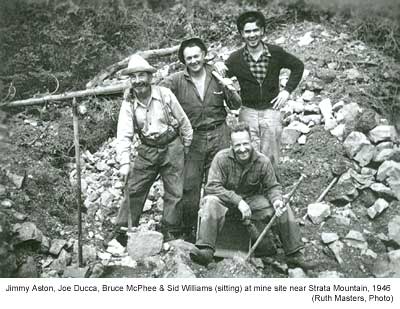 Local
Courtenay shoemaker and part-time prospector, James
(Jimmy) Aston had a unique way of finding gold and other precious
metals. He had a pair of leather gloves which in the fingers of one glove
he stashed samples of different metals and with a wand in hand he then
walked around waving it over the ground, just the way a water deviner
covers the ground searching for water under the surface. Jimmy also happened
to be well versed with water devining, therefore, it didn't appear unusual
for him to use this technique to find precious metals. In fact, he believed
it worked like a charm, unfortunately, he could never lay claim to the
fact that he had struck it rich from prospecting. It was while near Strata
Mountain in Strathcona Provincial Park with another part-time prospector,
Sid Williams,
that his glove and wand detected some sort of metal under the surface.
Local
Courtenay shoemaker and part-time prospector, James
(Jimmy) Aston had a unique way of finding gold and other precious
metals. He had a pair of leather gloves which in the fingers of one glove
he stashed samples of different metals and with a wand in hand he then
walked around waving it over the ground, just the way a water deviner
covers the ground searching for water under the surface. Jimmy also happened
to be well versed with water devining, therefore, it didn't appear unusual
for him to use this technique to find precious metals. In fact, he believed
it worked like a charm, unfortunately, he could never lay claim to the
fact that he had struck it rich from prospecting. It was while near Strata
Mountain in Strathcona Provincial Park with another part-time prospector,
Sid Williams,
that his glove and wand detected some sort of metal under the surface.
It was the closing of the summer of 1946, Jimmy and Sid had both been searching the streams and mountains that form the legendary Forbidden Plateau behind Mount Washington. Although there were numerous signs of colour in the rocks of the plateau, nothing appeared to be of any consequence. However, Jimmy became quite excited about the way the wand was moving over the ground near Strata Mountain. The initial digging turned up signs of gold in what appeared to be a prosperous vein. Unfortunately, the season came to a close, but they were determined to return the next year and undertake a more thorough search of the claim that they staked.
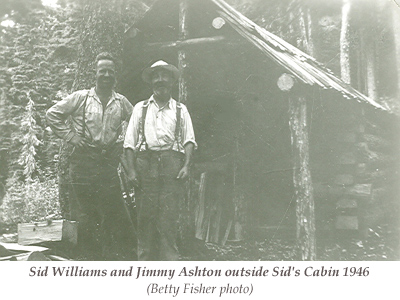 In
the summer of 1947 they returned with two other locals, Joe Ducca and
young Bruce McPhee, who were hired to work for a couple of weeks helping
them out with drilling and the construction of a cabin. Their temporary
home was a canvas tent they carried in and erected on a wooden platform.
The outline of the structure can still be seen near the diggings. The
frame of the cabin (which soon became known as Sid's Cabin) was log construction
from trees cut down nearby, however, it was the roofing shakes that the
men were most proud of. Some distance from the cabin a large punky fallen
yellow cedar was found that had good straight grained, knot-free, wood.
After sawing it into three foot lengths they then split the log into thick
shakes. It was Bruce's job to use a pack-board to carry all the shakes
back to the cabin where those original shakes are still in use today.
While construction was taking place the cabin had its first visitor. Courtenay's
Ruth
Masters was hiking in the area and not one to pass by without
offering to help, Ruth spent the day chinking the walls with moss to cut
down on the draft.
In
the summer of 1947 they returned with two other locals, Joe Ducca and
young Bruce McPhee, who were hired to work for a couple of weeks helping
them out with drilling and the construction of a cabin. Their temporary
home was a canvas tent they carried in and erected on a wooden platform.
The outline of the structure can still be seen near the diggings. The
frame of the cabin (which soon became known as Sid's Cabin) was log construction
from trees cut down nearby, however, it was the roofing shakes that the
men were most proud of. Some distance from the cabin a large punky fallen
yellow cedar was found that had good straight grained, knot-free, wood.
After sawing it into three foot lengths they then split the log into thick
shakes. It was Bruce's job to use a pack-board to carry all the shakes
back to the cabin where those original shakes are still in use today.
While construction was taking place the cabin had its first visitor. Courtenay's
Ruth
Masters was hiking in the area and not one to pass by without
offering to help, Ruth spent the day chinking the walls with moss to cut
down on the draft.
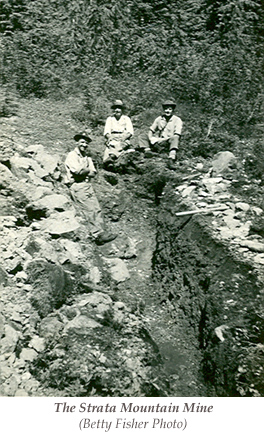 Although
the cutting and carrying of the logs was hard work, the hardest and most
tiring job was the drilling into the rock to take core samples at various
locations to get an idea of the extent of the gold vein. It required using
a long drill or auger and a heavy sledge hammer. The fretful job of holding
the drill fell upon Bruce while it was Joe's job to hit the end with the
hammer, subsequently, Bruce couldn't help closing his eyes and cringing
just as Joe struck the head of the drill. One missed swing of the hammer
and it would be Bruce's hands that would take the brunt of the steel on
the end of the hammer handle. Fortunately for Bruce, Joe's aim was good
and he never missed! It took many hours to drill one hole several feet
into the hard rock but eventually the extent of the vein was found to
extend for quite a distance and it looked promising.
Although
the cutting and carrying of the logs was hard work, the hardest and most
tiring job was the drilling into the rock to take core samples at various
locations to get an idea of the extent of the gold vein. It required using
a long drill or auger and a heavy sledge hammer. The fretful job of holding
the drill fell upon Bruce while it was Joe's job to hit the end with the
hammer, subsequently, Bruce couldn't help closing his eyes and cringing
just as Joe struck the head of the drill. One missed swing of the hammer
and it would be Bruce's hands that would take the brunt of the steel on
the end of the hammer handle. Fortunately for Bruce, Joe's aim was good
and he never missed! It took many hours to drill one hole several feet
into the hard rock but eventually the extent of the vein was found to
extend for quite a distance and it looked promising.
After reporting on the extent of their find, Sid and Jimmy were able to persuade a large mining company to come out the following year to assess the site for further development. The major drawback was that this claim was in a provincial park, however, they did test drill the site with a diamond drill. The trays of the core samples can still be seen laying on the ground partially buried under Heather from the years in the open.
Sid's Cabin is a small two bunk refuge with a wood stove that serves as both a summer and winter base for hikers who want to climb or ski up nearby Mount Albert Edward. The cabin is well secluded in the trees and can be easily missed if one doesn't know where to look. Although it is getting on towards sixty years old, with care the cabin can still continue to serve those who seek its shelter. The most important factor in its up-keep is for those who use it to leave it in better shape than they found it - a small price to pay for the use of the cabin.
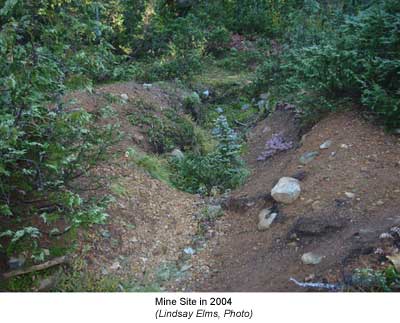 |
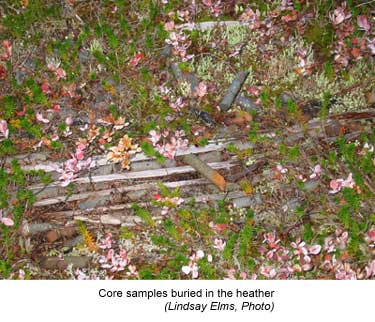 |
How to order | | About the Author || Links || Home
Contact:
Copyright ©
Lindsay Elms 2001. All Rights Reserved.
URL: http://www.beyondnootka.com
http://www.lindsayelms.ca